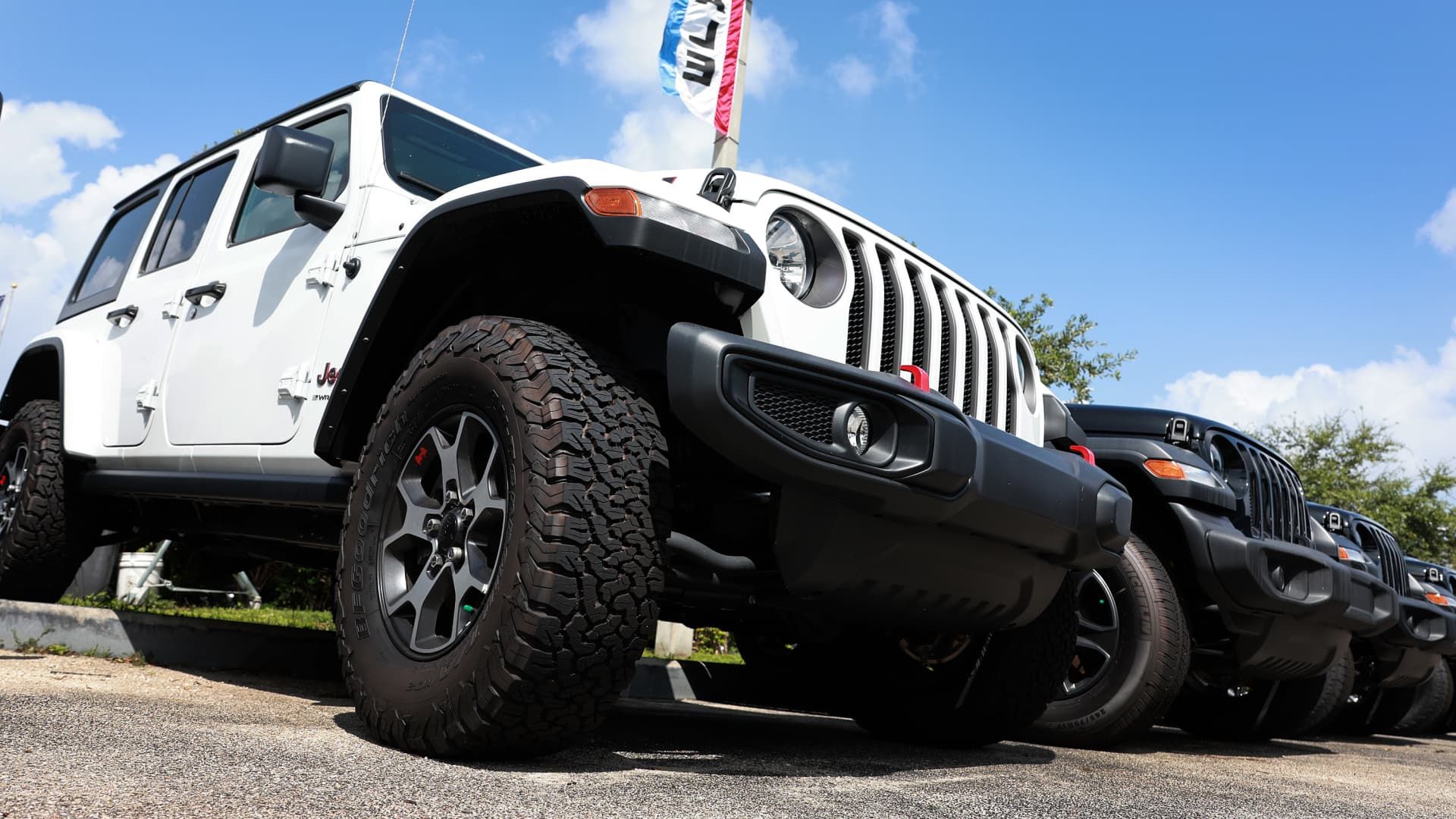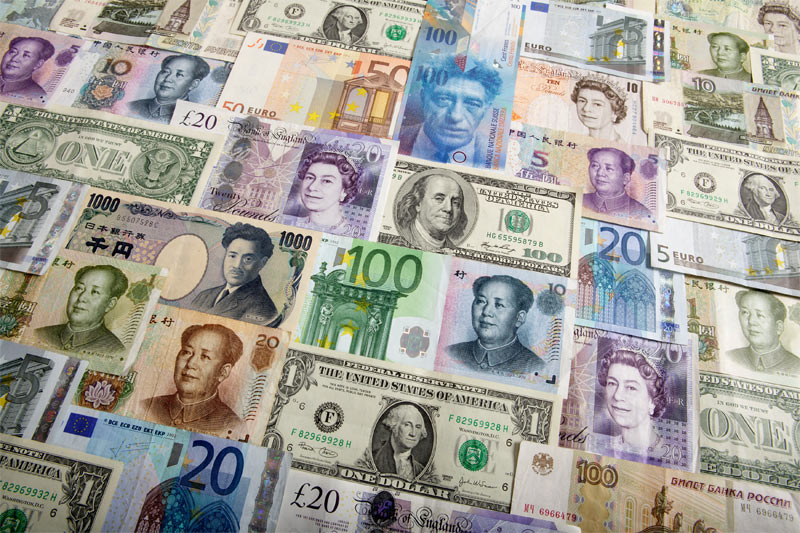New Jeep vehicles sit on the lot of a Dodge Chrysler-Jeep Ram dealership on October 3, 2023 in Miami, Florida.
Joe Raedle | Getty Images News | Getty Images
DETROIT – The latest time-consuming actions Ford Engine The U.S. auto industry, which fell more than 18 percent in one day, including last week, was on the brink of bankruptcy during the Great Recession.
Ford, which avoided bankruptcy in 2008-09, is far from suffering such a disaster, but the freefall in its shares after the company missed Wall Street's earnings expectations is a prime example of the uphill battle facing automakers for the rest of the year.
The U.S. market, a profit engine for most automakers, is normalizing after years of record prices, low vehicle inventories and resilient demand. Inventories, especially for Detroit automakers, are rising and vehicle prices are slowly declining.
Wall Street has been expecting just such a set of circumstances for some time, with the cyclical nature of the auto industry ushering in a period of decline.
Ford, GM and Stellantis shares
“Investors who believe the auto sector can outperform profitability expectations with better-than-expected earnings and buybacks should think twice. Auto fundamentals may be peaking (see rising incentives and delinquencies). Over time, this may catalyze lower spending and M&A,” Morgan Stanley analyst Adam Jonas said in a note to investors on Friday.
Jonas' comments came after the company downgraded GM from “overweight” to “equal weight” last week, adding that “the auto industry remains one of the most challenged in the world in terms of competition, excess capacity, cyclical and secular risks.”
Adding to the industry's challenges are individual automakers' problems, as well as uncertainty surrounding the adoption of all-electric vehicles, in which automakers have invested billions of dollars and which remain largely unprofitable.
Ford shares had their worst week since March 2020, falling 20% to close at $11.19 on Friday. GM shares fell 8.7% last week to $44.12. Stellantis shares fell 12.6% last week to $17.66.
Managing Director
For General MotorsInvestors were wary of setbacks in the growing business, a waning bullish trend during the second half of the year and fear the automaker's earnings power has peaked, Wall Street analysts said.
More electric vehicle sales are one reason GM, which has raised its annual financial forecast twice this year, expects the second half to underperform the first. The company expects its second-half adjusted earnings to be between $4.7 billion and $6.7 billion, or $3.82 to $4.82 adjusted earnings per share. That compares with $8.3 billion, or $5.68 adjusted earnings per share, in the first half of the year.
The automaker also expects a 1% to 1.5% decline in vehicle prices as well as $1 billion in additional spending, including $400 million in additional marketing costs to support vehicle launches. GM is looking to ramp up production of loss-making electric vehicles as it aims to make the vehicles profitable in terms of output or contribution margin by the end of the year.
Analysts are also concerned about GM’s continued losses in China, which has historically been a profit driver for the company. The automaker’s Chinese operations posted a $104 million capital loss, the unit’s second straight quarterly loss after hitting a roughly 20-year low in 2023.
“We have been taking steps to reduce our inventories, align our production with demand, protect our prices and reduce fixed costs. But it is clear that the steps we have taken, while significant, have not been enough,” GM CEO Mary Barra said during the company's earnings conference call on Tuesday. “We expect the remainder of the year to remain challenging.”
The automaker is still expected to post strong results for the second half of the year, build on its solid cash flow position and make billions of dollars in share buybacks to return money to investors.
Ford
The same cannot be said unilaterally of GM's closest rival, Ford, which opposed any share buybacks and instead relied on the company's dividend to reward investors.
Several Wall Street analysts noted the difference in share buybacks between the companies, citing the Ford family's voting control of the board and special shares.
“Given the high cash balance, there were hopes for a special dividend or even a share buyback. In retrospect, this was probably just investor pressure compared to GM's policy. But Ford doesn't seem likely to change its stance,” UBS analyst Joseph Spak said in a note to investors on Thursday.
The new Ford F-150 pickup truck rolls down the assembly line at the Dearborn Ford Plant on April 11, 2024 in Dearborn, Michigan.
Bill Pugliano | Getty Images
Ford expects adjusted earnings for the second half of the year to be between $2 billion and $3 billion, compared with $5.5 billion in the first half.
The company reconfirmed its 2024 guidance despite second-quarter adjusted earnings per share coming in 21 cents below expectations. The automaker reported an additional $800 million in unexpected warranty costs compared to the previous quarter.
To deliver on its second-half results, Ford Chief Financial Officer John Lawler revised the company’s guidance for the final six months of the year for its traditional Ford Blue and Ford Pro operations. Full-year EBIT expectations are raised for Ford Pro to a range of $9 billion to $10 billion, driven by stronger growth and a favorable product mix. However, guidance is lowered for the company’s Ford Blue segment to a range of $6 billion to $6.5 billion, reflecting higher warranty costs.
“We are disciplined in our use of capital, have the right product portfolio and are consistently generating cash to reward our shareholders,” Lawler told investors Wednesday. “We are relentlessly looking for new ways to improve our business and remain focused on driving improvements in both quality and cost.”
Stellantis
Transatlantic automaker Stellantis is arguably facing the most challenging second half of the year, particularly when it comes to its U.S. operations.
Speaking to reporters, Stellantis CEO Carlos Tavares said many of the company's problems stem from its U.S. operations, which he previously said were being plagued by “arrogant mistakes” around vehicle inventory levels, manufacturing and sales strategies.
Last year, Stellantis was the only major U.S. automaker to report a decline in sales compared to 2022.
In the first half of this year, the firm's sales in the United States fell by 16%, while its share of the North American market was 8.2%, a drop of 1.8 percentage points.
Stellantis CEO Carlos Tavares holds a press conference before visiting the carmaker's Sevel plant, Europe's largest van manufacturing facility, in Atessa, Italy, January 23, 2024.
Remo Casilli | Reuters
Despite the ongoing issues, Stellantis reconfirmed its 2024 guidance of a double-digit adjusted operating profit margin, positive industrial free cash flow and at least €7.7 billion in capital return to investors in the form of dividends and buybacks.
In the first half, Stellantis' adjusted operating margin was 10%. Its free cash flow was negative by 392 million euros and its return on equity was 6.65 billion euros.
Tavares hopes to achieve those goals with the help of 20 new model launches this year, the correction of problems in the United States and further price cuts to boost sales. He also did not rule out further staff cuts.
“It's a very tough industry, we're in a very difficult period and we all have to fight for performance,” Tavares said. “We'll have to work hard to deliver that performance.”
– CNBC Michael Bloom contributed to this report.









